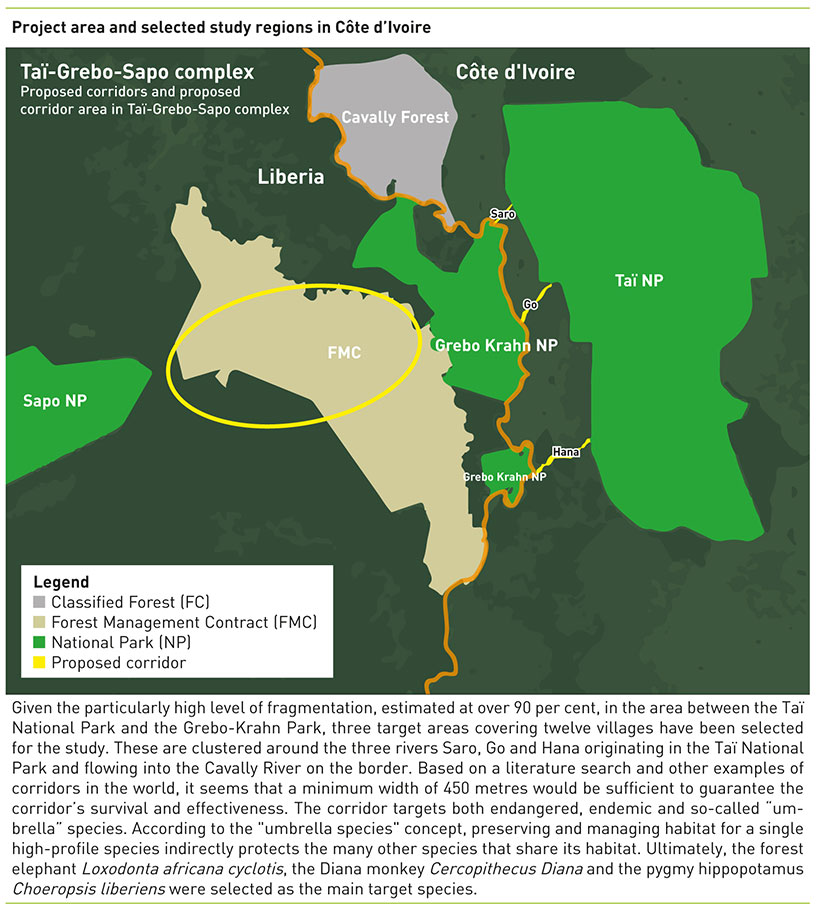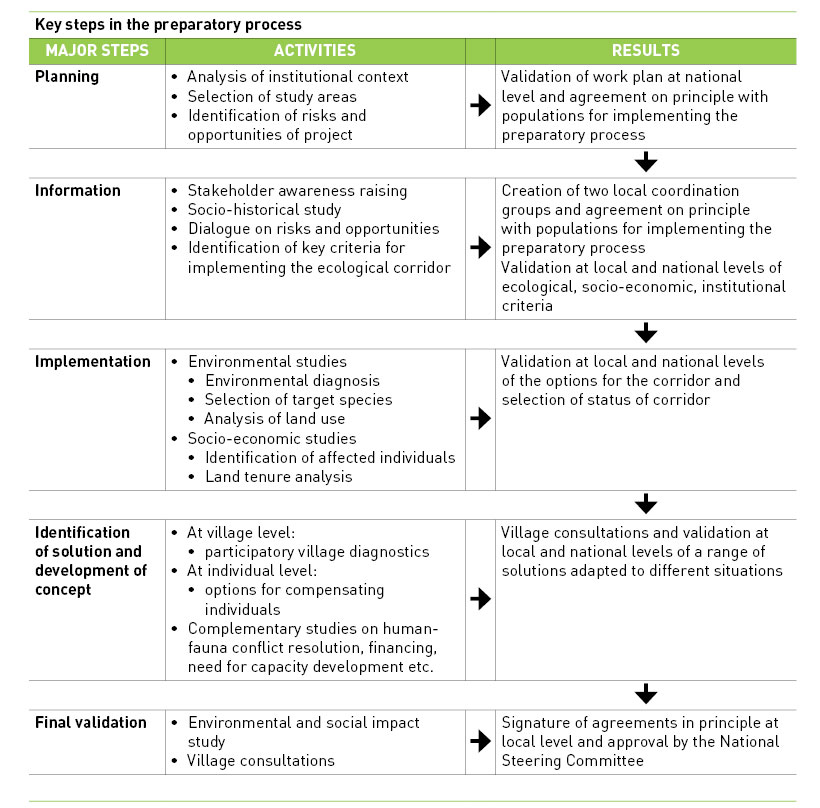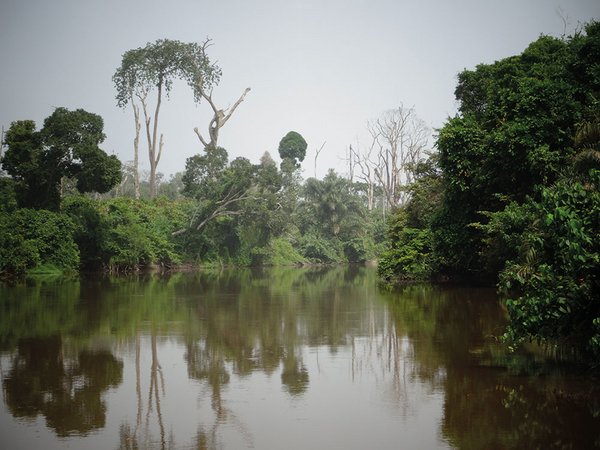 Download this article in magazine layout
Download this article in magazine layout
- Share this article
- Subscribe to our newsletter
Preserving biodiversity in a cross-border context
The Taï-Grebo-Sapo cross-border forest complex covers over 13,000 square kilometres of virtually intact tropical forest. It comprises the Taï National Park in Côte d’Ivoire, the two national parks at Grebo-Krahn and Sapo in Liberia, and several classified forests and/or forest concessions (see Map).
Project area and selected study regions in Côte d’Ivoire

All around it are rural areas principally dedicated to agriculture and mining. The population of Côte d’Ivoire doubles on average every 20 years, and this has resulted in destruction of natural environments around areas reserved for the development of cash crop farming of cocoa, coffee and rubber. The Taï National Park has accordingly become more and more isolated, with increasingly aggressive land use around its periphery. Compared with Côte d’Ivoire, nature is still relatively well preserved in Liberia, although mining, the boom in cash crop farming and poaching all pose a threat to biodiversity.
The forest blocks described above are very valuable for conserving biodiversity as they host over 1,200 plant species, 300 of which are endemic, and hundreds of animal species, such as the West African chimpanzee or the pygmy hippopotamus. The fragmentation of the territory is a real threat and even a matter of survival for some of these species, which has led to the idea of an ecological corridor between Taï National Park in Côte d’Ivoire and the Grebo-Krahn park in Liberia. The “Biodiversity Conservation Project” was created in the two countries as one of several projects to implement the corridor (see Box at the end of the article).
The first step: gaining the populations’ support in Côte d’ivoire
In Côte d’Ivoire, the populations in the areas concerned recognise the park’s contribution to their agricultural production in terms of rainfall and soil fertility (see Box below), and they do not oppose such a project in principle, as long as it does not affect them directly. However, they are generally wary of the idea of a corridor in this area, which they argue would reduce their income from farming and mean that all sides would attach greater weight to the animals at the expense of people and its development.
THE ECOSYSTEM SERVICES OF THE TAÏ NATIONAL PARK
An assessment of the value of the Taï National Park in 2015 by the Côte d’Ivoire Parks and Reserves Foundation and the Côte d’Ivoire Office of Parks and Reserves showed that the Taï forest makes a positive contribution to the local climate, which, thanks to good rainfall, supports sufficient cash crop production for over 180,000 farmers, and whose bordering area alone contributes 40 per cent of national cocoa production, not to mention rubber or palm oil production.
The project is accordingly starting with a two-year preparatory period (February 2017 to January 2019). The main objective of this preparatory phase is to confirm the ecological and socio-economic feasibility of the corridor and ensure its social acceptance. Indeed, natural resources cannot be conserved in the face of opposition by the people, particularly in a context of latent social conflict and local economic challenges.
After an intense consciousness-raising campaign, popular reservations about the project were still strong. In order to better understand these reservations, the local team had discussions with key individuals and with communities on the history of the area and the conflicts which the corridor could potentially ignite. This study was a major asset, as it highlighted certain aspects of the painful history of the communities in the region. As a result of more or less recent political events (war in Liberia in the 90s, post-election crisis in 2011 in Côte d’Ivoire) and frequently misunderstood decisions in connection with the management of Taï National Park, they felt fobbed off in this strip of land, which is just four kilometres wide in parts and at the same time marginalised in an area with little economic development.
Through a participatory search for solutions identified on the basis of negotiations, this phase is leading in a series of steps to the definition of conceivable types of activities which could appeal to the local communities in the corridor and possibly bring them to accept the project. The negotiations are taking place at the level of individuals, growers and landowners and at village level, and aim at formulating and achieving acceptance of a concept for approval by a National Steering Committee and submission to the Council of Ministers.
The alternatives proposed to the communities
The participatory diagnostics in each of the twelve villages enabled a prioritisation of the villages’ problems by sector of activity and to identify solutions which they could agree on. Support in the fields of health (healthcare centre, maternity centre), education (school construction, assistance with educational material) and food security should be considered as compensation for acceptance by local populations of the project to implement the corridor. In agriculture, which is the leading activity in the region, in order to improve the standard of living of the populations, support for communities in managing low-lying land scheduled for rice growing, or support to improve productivity of subsistence crops would seem to be an essential and inevitable part of assistance to local populations.
In addition, there is job creation for young people, for example as corridor rangers or through development of tourism, training and support for women in activities connected with tourism (e.g. catering) and income-generating activities (e.g. value chains for non-wood forest products). For those people directly impacted by the ecological corridor, it is planned to propose a range of solutions defined in co-operation with the growers and their stakeholders. Some ideas have already been advanced, for example reallocation of their land for the corridor. The landowners could be rewarded with payments for environmental services if they commit to afforesting or reafforesting their land where it is integrated into the corridor. This commitment can take the form of an individual or collective contract, depending on the status of land ownership. In addition, those on the periphery of the corridor who agree to follow agroforestry practices (for example a living hedge) and improve the forest cover could also benefit from these payments.
Project steering
Several levels of participation have been jointly defined with the stakeholders. First, the Côte d’Ivoire Government has issued a ministerial decree establishing a National Steering Committee (NSC) which aims to be inclusive by virtue of the active participation of all the stakeholders in project decision-making. The NSC has representatives from the ministry departments, the Côte d’Ivoire Parks and Reserves Foundation and the Côte d’Ivoire Office of Parks and Reserves, regional and local government, national MPs, civil society representatives (NGOs and traditional local authorities) and technical and financial partners as observers.
Subsequently, two local co-ordination groups were established, one for each sub-prefecture involved, with effective involvement of the village heads and prefectorial authority to appoint members from all the communities (indigenous people, outsiders, youth, women). The rules of procedure are similar to those of the NSC but have a local basis. Entities which can assist with clarification and the orientation of the study have been admitted to these co-ordination groups as observers. This is the case for the project team providing the secretariat and the Côte d’Ivoire Office of Parks and Reserves, the local representation of the ministry of agriculture and the local representation of the ministry of forests. Besides the meetings organised by the project team, these village members relay information to their communities, and in the interests of transparency participate systematically in every stage of the process (activities, studies etc). In conflict resolution, it is also important to note the unconditional support of local authorities and of the NSC members, who can explain the current process and calm communities or individuals who are still reluctant.

Factors for success and impact
Whatever the outcome of this preparatory process, communities have been able to share their concerns, and have highlighted: (i) the need to preserve the current social balance between communities and between growers and landowners, (ii) the need to be heard and respected in keeping agreements, and (iii) the need to be assisted with good management of compensation, or, to put it briefly, turning this biodiversity conservation project into a venture that takes human beings into account.
At the local level, people’s participation in the decision-making process is a guarantee of success and an experience which is virtually unknown to these communities. At the end of this preparatory process, planned for the start of 2019, a project concept will be proposed for validation by the communities that is to take the form of a written statement of their support for the project, before validation at national level. According to the project team, respecting all the actors and ensuring transparent communication is the right way to enable the implementation and sustainable management of an ecological corridor.
WHY CREATE AN ECOLOGICAL CORRIDOR IN THE TAÏ-GREBO-SAPO COMPLEX?
For social and/or environmental reasons, individual groups of animals (young subadults or adults) leave their native habitat to find new territory for food and, often, reproductive partners. This phenomenon ensures the survival of these animals. Isolation of protected areas affects not only the distribution of animals for access to habitat and food, but increases inbreeding in groups isolated in a given area. To avoid a situation which could result in the disappearance of species and negative changes to the ecosystem, it appeared essential to create an ecological corridor that would join the Taï National Park in Côte d’Ivoire and the extensive Grebo-Krahn-Sapo forest in Liberia. Another benefit of strengthening forest continuity in this complex is the conservation of dense forests with their biodiversity and services, particularly for cash crop agriculture in Côte d’Ivoire, where most cocoa production comes from the region around the Taï National Park.
THE BIODIVERSITY CONSERVATION PROJECT – ITS HISTORIC NATURE AND THE ACTORS INVOLVED
Although the idea of conserving this forest complex goes back several decades, the origins of the Biodiversity Conservation Project date from 2009, when a bilateral workshop was organised by UNEP-GRASP (United Nations Environment Programme Great Apes Survival Partnership) and the Wild Chimpanzees Foundation (WCF) with the principal authorities in charge of managing the forests, parks and reserves of Liberia and Côte d’Ivoire to discuss the creation of an ecological corridor in this area. The meeting marked the creation of a cross-border committee to manage the Taï-Grebo-Sapo complex, comprising various national entities (Ministry of the Interior, FDA, OIPR, FPRCI, etc.), international organisations (Mano River Union, for example) and NGOs involved on one side or the other of the frontier, showing the commitment of the two countries to biodiversity conservation.
This appeal led to the launch of three projects to strengthen ecological connectivity in 2017. They have the same objective, namely to connect the three large forest blocks Taï, Grebo and Sapo in order to permanently conserve the biodiversity of this area. Specifically, this translates into (i) the creation of a unique ecological corridor between the Sapo, Grebo-Krahn and Taï parks, (ii) the creation/restoration of intermediary areas (community/ residual forests) and the recognition of Grebo forest as a national park at the end of 2017, (iii) capacity development of the local and national authorities and (iv) the development of support measures for the bordering populations affected by the corridor.
Primarily funded by the German Federal Ministry for Economic Cooperation and Development (BMZ) and the US Agency for International Development (USAID), these projects are being implemented in a complementary way by various entities, the Côte d’Ivoire Ministry of the Environment and Liberian Forest Development Authority (with funding by Germany’s Kreditanstalt für Wiederaufbau – KfW), Deutsche Gesellschaft für Internationale Zusammenarbeit (GIZ) and WCF. The Biodiversity Conservation Project is one of the three projects.
Karim Ouattara is a researcher at Centre Suisse de Recherches Scientifiques (Swiss Scientific Research Centre) in Abidjan, Côte d’Ivoire and an expert assigned to the project.
Blandine Schaffner is an expert in charge of the preparatory process for AHT GROUP AG, based in Abidjan, Côte d’Ivoire.
Elisée Napari Yeo is the project’s Focal Point at the Ministère de l’Environnement, de la Salubrité et du Développement Durable (Ministry of the Environment, Health and Sustainable Development) in Côte d’Ivoire.
Contact: schaffner@aht-group.com





Add a comment
Comments :
for further information please contact the authors (see email address above).
Best regards,
The Rural 21 team